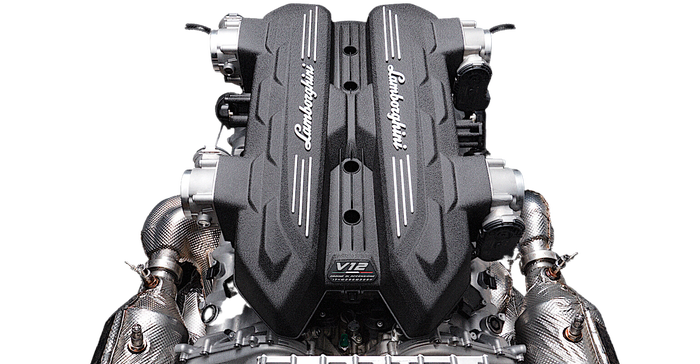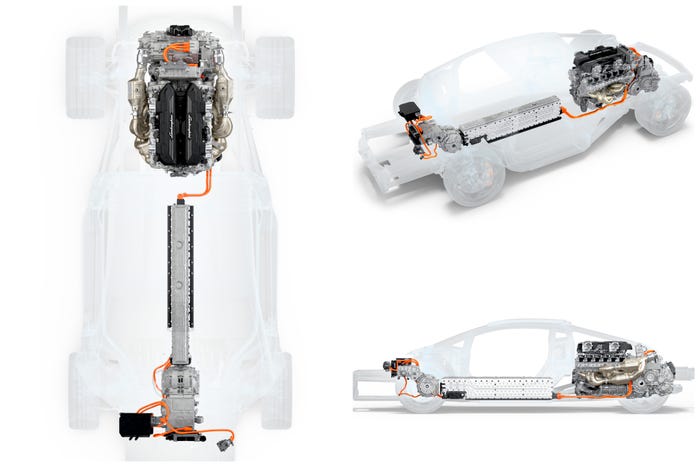Lamborghini Electrifies its Future with a Hybrid V12
Lamborghini’s clean-sheet L545 V12 eschews turbocharging in favor of a hybrid-electric boost.

Lamborghini's L545 6.5-liter V12 shares no parts with its predecessor.Lamborghini
The naturally aspirated V12 engine has been the cornerstone of Lamborghini cars since the very first 3500GT of 1963 inaugurated the company’s automotive production. When engineers moved that engine from the front to behind the cockpit to create the prototypical V12 super sports car with the Miura in 1966, Lamborghini established the pattern for such cars that continues today.
But the sun is setting on such powerplants, as other manufacturers have switched to smaller-displacement turbocharged engines with fewer cylinders in a bid to phase in electric assistance. The V6-powered McLaren Artura we recently drove is a prime example, along with the Ferrari 288GT.
But to replace Lamborghini’s flagship V12 super sports car, the Aventador, the company has retained its signature engine even while adding electric power, to produce the most powerful regular production model Lamborghini yet. Combining an all-new V12 combustion engine with a trio of electric motors produces a combined 1,000 horsepower driving all four wheels.
With the likely end of combustion-powered vehicles on the horizon, it would be understandable if Lamborghini just bolted an electric motor to the current V12 and rode that motor into the sunset. But that’s not the course the company chose, so there is an all-new V12 engine powering its hybrid model.
“The Miura and Countach established the V12 engine as in icon of Lamborghini,” noted company chairman and CEO Stephan Winkelmann. “However, things change and we have new challenges in front of us right here and right now,” he continued. “Geopolitics are a constant companion to all of our planning.” As a result, the company will apply hybrid-electric power to all of its models, starting with the Aventador’s replacement, code-named LB744.
The engine’s most fundamental difference from its predecessors relates to the engine’s position in the car. As it has done since the Miura, the new L545 V12 resides behind the car’s cockpit. However, it connects to a transverse 8-speed dual-clutch gearbox bolted behind the engine, over the rear axle.
The Miura’s engine and transaxle were transverse, sitting sideways across the back of the car. The first-generation Acura NSX employed this same layout. But when the Countach replaced the Miura, the engine was rotated 90 degrees into a longitudinal position, which lent that car its alphanumeric designation of LP400. The Countach’s transmission was in front of the engine, sitting the car’s central tunnel, just as a front-engine, rear-drive car’s would have been.
The new L545 V12 engine, therefore, is built 180 degrees differently than the current generation of engines, as it sends power out the back to the gearbox that is mounted behind it rather than out the front to one sitting in the car’s tunnel. While they were changing the engine’s fundamental orientation, Lamborghini powertrain engineers also refined many of its components even while maintaining its 6.5-liter displacement.
Consider that the L545 is more than 37 lbs. lighter than the old engine and the total combustion engine weight is 480 lbs. (218 kg), making it the company’s lightest V12 ever. It spins to a new 9,500-rpm rev limit and features a 12.6:1 compression ratio rather than the 11.8:1 compression in the Aventador, producing 814 horsepower.
That makes the L545 Lamborghini’s most powerful engine ever, and that’s before the assistance of the three electric motors. By comparison, the first-generation 3.5-liter V12 redlined at 6,500 rpm and was rated at 280 hp.

The L545’s intake tracts have been refined to flow enough air to support the higher revs. And in place of knock sensors that let the ECU keep the ignition advance on the edge of inducing pre-ignition detonation, the new engine has switched to measuring the state of the combustion using a pair of computers that measure the ionization across the spark plug gaps.
The spent gases exit through new headers that are designed for optimal flow, with extra attention given to the resulting sound, so that the L545 is claimed to be “melodious at low revs, rising to a natural harmonious crescendo.” It makes sense to double down the V12’s sound to leverage this advantage over more mundane-sounding turbocharged V6 and V8 rivals.
The thrill of the V12’s character is important to its appeal, so that was Lamborghini’s focus, explained chief technical officer Rouven Mohr. “It has performance never seen on a street Lamborghini before,” he said. “But it is not only about the numbers. It is also about the heart. It is the best-sounding Lamborghini ever. We have worked intensively on the revving-up behavior and we’ve worked on [reducing] the sharpness of the frequencies in the engine note.”
The L545 bolts to a compact transverse 8-speed dual-clutch transmission (DCT) that was designed in-house at Lamborghini and is manufactured by Italian gearbox specialist Graziano. That is the same company that McLaren uses for its sports cars. This new transmission replaces the old single-clutch unit in the Aventador that has been long criticized for its clunky gear changes. This new one is smaller, lighter, and faster-shifting than the 7-speed DCT used in the V10 Huracan.
The transmission is 22.0 inches (560mm) long, 29.5 inches (750mm) wide, and 22.8 inches (580mm) high, and it weighs just 425 lbs. (193 kg.) including its 147.5-hp. (110-kW) electric motor, which is made by Mahle in Slovenia. The motor serves as the engine’s starter, it generates power to charge the battery pack, and it can assist the front electric motors when needed to reverse the car.
An interesting application of this motor is that it provides traction control for the V12. Where most traction control systems apply the brakes to limit wheelspin, in this application, the electric motor applies a load to the engine to stop wheelspin, generating power in the process that goes into the battery for later use.
Interestingly, the manufacturer’s identification plate on the e-motor indicates a rating of 140 kW, so perhaps this motor’s output is limited by the power delivery of the 3.8-kilowatt-hour lithium-ion battery pack. If so, future models with bigger batteries might be able to tap the motor’s full potential. That battery pack lives in the central tunnel in the space where the Aventador’s transmission mounts today for optimal mass centralization and a low center of gravity. When driving in electric-only mode, the powertrain has a range of about 6 miles (10 km).
The V12 can recharge the battery pack in as little as six minutes or it can be topped off from empty using a Level 2 AC charger in half an hour.
In addition to this thoroughly revamped V12 combustion engine, its new gearbox, and its hybrid-electric drive system powering the rear wheels, there is also a two-motor electric-only drivetrain for the front wheels. This system includes a pair of British Yasa axial flux electric motors and an Italian Texa inverter mounted between the front wheels.
Each of these motors contributes 147.5 hp (110 kW). The compact, pancake-style motors weigh only 40.7 lbs. (18.5 kg), and their power not only drives the front wheels but provides the power needed for torque vectoring, distributing power precisely left-to-right.
About the Author(s)
You May Also Like





